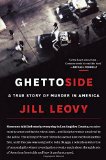Plague. Even today, the word retains fearsome connotations. But according to Jill Leovy, there’s been a plague in America for several decades: the murder of black males, mostly by other black males. In Los Angeles County, for example, even though black men were just six percent of the population, they accounted for 40 percent of the homicide victims
In fact, homicide became so commonplace it reached “dog bites man” status. In the mid-2000s, the Los Angeles Times reported on only about 10 percent of the homicides in L.A. County. In late 2006, Leovy, a Times police beat reporter, launched a blog called The Homicide Report for the newspaper. That work and twice “embedding” with homicide detectives in the L.A. Police Department’s 77th Division — an area in South Central L.A. dubbed “Ghettoside” by a Watts gang member — ultimately led to the recently published Ghettoside: A True Story of Murder in America.
 Focusing in large part on one detective and built largely around one murder, the book explores this “bizarre phenomenon.” And Leovy reaches a conclusion many might consider outlandish. She contends black-on-black murder has become endemic because there is “too little application of the law, not too much.” She says the law fails black people because police have focused too much on so-called preventive strategies rather than solving murders. The former approach, Leovy says, results in harassing people on small pretexts and charges of heavy handedness instead of catching and punishing murderers.
Focusing in large part on one detective and built largely around one murder, the book explores this “bizarre phenomenon.” And Leovy reaches a conclusion many might consider outlandish. She contends black-on-black murder has become endemic because there is “too little application of the law, not too much.” She says the law fails black people because police have focused too much on so-called preventive strategies rather than solving murders. The former approach, Leovy says, results in harassing people on small pretexts and charges of heavy handedness instead of catching and punishing murderers.
Ghettoside‘s supports its thesis with its main protagonist, John Skaggs. Skaggs is an LAPD homicde detective who combines compassion and empathy for victims and their families with dogged investigation. A number of his cases portray his adroit investigative techniques, including relentless on-the-street efforts to find and interview potential witnesses. Given that speaking to the police — let alone testifying in court — can put a person’s own life in danger, Skaggs also is seen encouraging and babysitting witnesses in this process. The first half of the book uses the work of Skaggs and other detectives to show the breadth of the problem and the inner workings and dilemmas of homicide investigations. Although coming into greater focus in the second half of the book, the the book builds around the murder of 18-year-old Bryant Tennelle, shot down while walking along a street pushing his bicycle and carrying a root beer. Tennelle wasn’t a gang member but happened to be wearing a baseball cap associated with an area gang. By chance, he is the son of a highly respected African-American LAPD homicide detective who lives in Ghettoside. Together, the two angles illustrate the difficulty — both in terms of resources and public cooperation — in dealing with murders that frequently have some gang involvement or relationship.
Leovy’s approach, particularly in the first half of the book, tends to introduce a lot of other cases and names, which can be confusing at times and occasionally portray people in almost walk-on roles. While they also let us see victims’ families and inside the criminal justice system, they have a tendency to distract from the story arc. Similarly, while internal LAPD politics and priorities certainly play a significant role in Leovy’s thesis, Ghettoside at times has a sort of “Inside Baseball” sense to it. Despite this, Leovy never really seems to directly address the extent to which Tennelle’s father being a cop impacted the resources and efforts directed toward the investigation of his murder.
Still, Leovy effectively combines journalistic and sociological inquiry to give a very readable and unprecedented look at what too many Americans shrug off as simply “inner city” gang violence. Ghettoside helps shed a light on not only the problem but its victims. Perhaps as important, it reinforces that, as one detective puts it, even if a murder victim was a prostitute, “She’s some daddy’s baby.”
…when people are stripped of legal protection and placed in desparate straits, they are more, not less, likely to turn on each other.
Jill Leovy, Ghettoside








Sounds like a powerful book. Does it address what to me is the most confounding question of all when it comes to this kind of violence…why black leaders, those with a national voice, continue to ignore the real problem in ghetto communities and, instead, continue to focus on police brutality as the main problem faced by minority populations? Seems to be a terrible shirking of duty and responsibility on their part…all the way from the Jackson/Sharpton level, right on up to the president and Attorney General.
It doesn’t, Sam, and I agree that it clearly deserves more attention from both national and community leaders.